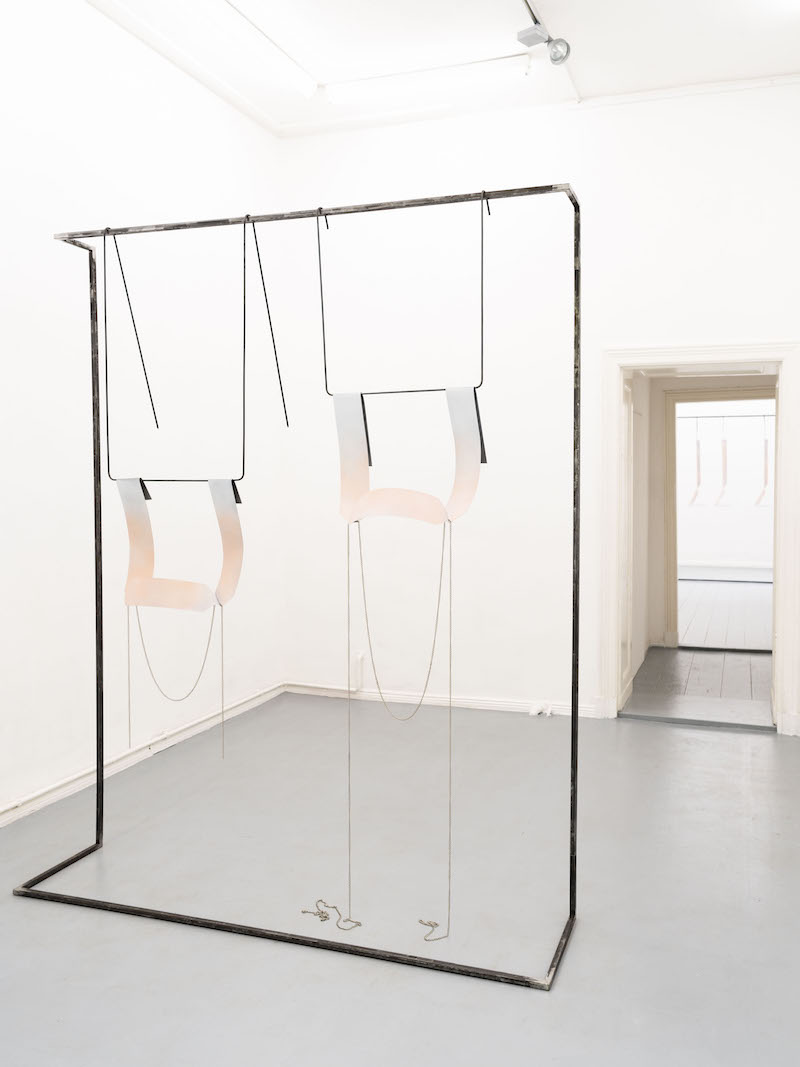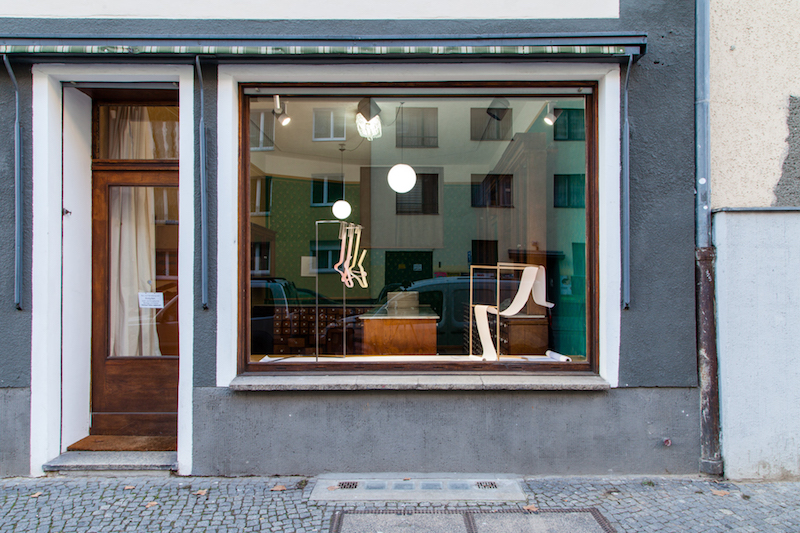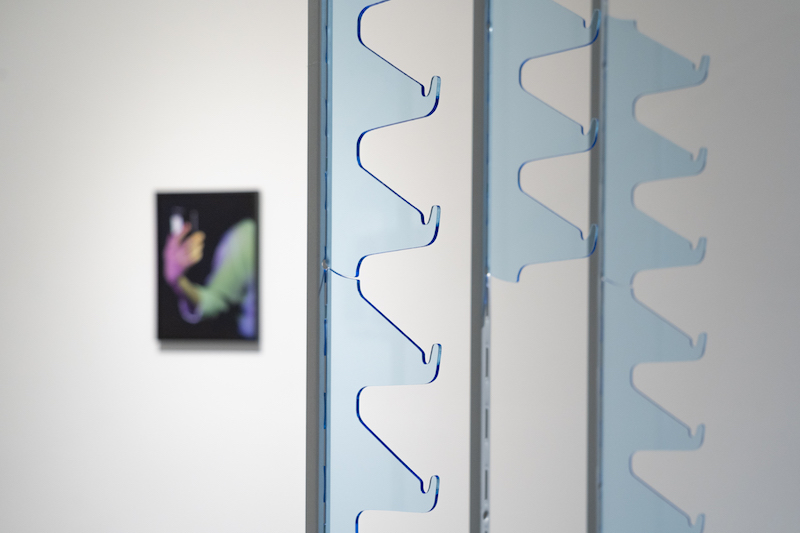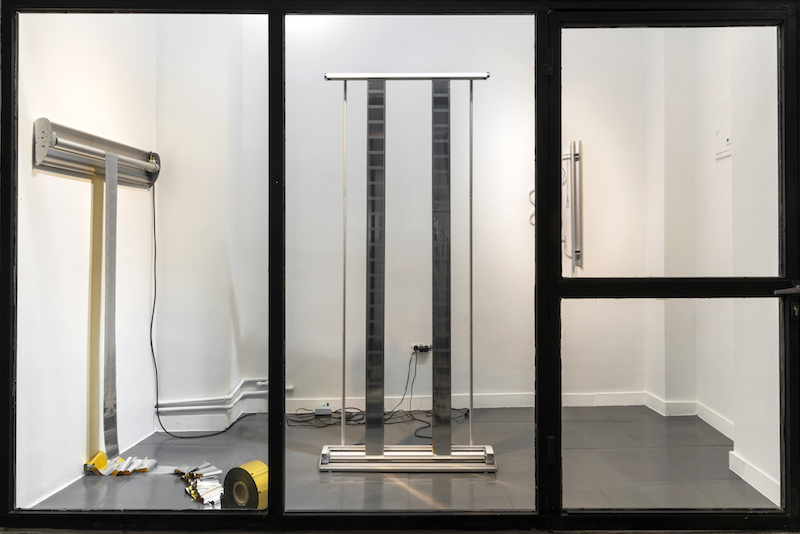by Cristina Ramos // Aug. 20, 2024
This article is part of our feature topic Desire.
Antonia Breme is an artist born and based in Berlin, whose practice re-thinks the aesthetics of displays in window design, abstracting them through new sculptural forms. In this way, consumerist and capitalist desire gets subdued, expanding the viewer’s senses and activating our imagination beyond the object itself. Through her refined sculptural craft and attention to detail, Breme’s works demystify the technical allure of packaging paper, wall rails or banner displays in such a way that both the inner-workings of desire and her artistic process are rendered visible. In her exhibitions, Breme creates an experience that activates the sensory and emotional affects through which the commercial world attempts to reach us, pushing us to re-evaluate our relationships to consumption. We spoke to Breme about how her sculptures contribute to a critical lens on marketing strategies and the manufacturing of desire.

Antonia Breme: ‘V (Virtus),’ 2021, steel, spray paint, steel chain, foam, dimensions variable, installation view at HilbertRaum, Berlin, curated by Hannah van Ginkel // Courtesy of the artist, photo by Gernot Seeliger
Cristina Ramos: Thinking through display evokes the gesture of exposing something. However, in your practice you use the haptic qualities of display objects themselves, creating a very tactile experience. Can you say something about why you choose to do this?
Antonia Breme: I am interested in display structures and strategies that are being applied in order to evoke desire within commercial contexts, such as shop window displays—instruments I came across during my time as a window dresser for a fashion designer (and still through occasional commissions within this context). Deriving from aspects such as decoration, drapery and display, those instruments hold the function of enabling goods to immediately catch the viewer’s eye, always supporting the goal of selling.
By picking up and by integrating those structures and strategies of creating desire within my sculptures and installations, my aim is to expose those very structures and mechanisms that are usually operating in the background but have a major influence on the dynamics of consumer culture. However, by doing this, I am aware that I am walking a fine line, which I again and again reflect within my artistic process: while making use of those very structures and mechanisms of creating desire in the way I am handling and shaping the materials I am working with, I am at the same time stripping bare this commercial context by removing its actual goods.
For example, with my installation ‘V (Virtus)’ (2021), the sculptural display hangers I originally custom made to present Cape Bag (biodegradable rain capes) by the research-based fashion label Weather Underground (originally displayed in the context of a shop window installation) were stripped bare and thus exposed as the “main actors,” still carrying their original function—visible within their gesture—but enabling a sculptural experience beyond their function of presenting goods.
CR: Do you aim to awaken any specific awareness in your audience?
AB: For me, this act of stripping bare carries the potential of creating sculptural experiences that can unfold through this “commercial” context and beyond. Here, material always plays an important role for me: within my artistic work process, I often feel like I am “thinking with the material” while bending and shaping it, while reflecting on sculptural questions and always paying great attention to the detail. Raw and sometimes rough material is being shaped into delicate forms, resulting in sculptures and installations that are indeed characterized by a sensorial tactility, enabled through the very strategies of creating desire. I hope to create installations that enable a sculptural and tactile experience for the viewer and that are able to withstand the fast and relentless world of consumption, by creating a moment of dwelling.

Antonia Breme: ‘Something about daydreaming,’ 2019, steel, acrylic glass, oak wood, paper, spray paint, pigment, aluminium, dimensions variable, installation view at Knopf Paul, Berlin, as part of the group exhibition ‘Constructing Desire #4: I’m so fucky’ // Courtesy of the artist, photo by Christian Lübbert
CR: I first heard about your practice when you were curating the series ‘Constructing Desire’ together with Gabriela Acha in Knopf Paul, the emblematic shop in Kreuzberg that stocks literally any button one can dream of. Through which angle were you thinking about desire?
AB: The starting point of the series ‘Constructing Desire’ was the opportunity to use the window (and showroom) of the legendary button shop Knopf Paul in Berlin-Kreuzberg as a temporary exhibition space in 2018/2019. For me personally, the shop window itself and its characteristics of a stage were an interesting starting point: a framed space oscillating between 2D and 3D, between surface and depth, bound by a glass pane and its reflections—at times confronting the viewers with their own reflection, occasionally triggering vain moments.
Together with Gabriela Acha, our aim was to create a space to reflect on different aspects touching the topic of desire, deriving from the idea of it being a construct bound by commercial aspirations. The idea of a construct based on commercial aspirations speaks in a critical tone, which we used as a frame to reflect on aspects we were interested in as an artist and curator: in different group exhibitions installed in the shop window and showroom we reflected on aspects such as the aesthetics of commodification/the art work as commodity, the political dimensions of objecthood and alternative ways of operating within the commercial art world.
I see my curatorial work as an extension of my own artistic practice, which carries the potential of bringing together different artistic voices and thus opening up a space to reflect on topics framed by the commercial context of the shop window—a space that is situated in public and accessible to everyone and thus contributing to the democratization of art reception. Currently, I am following up on this approach with ‘Reflection Series,’ a series of exhibitions located in the shop window of New Toni, Berlin, where I am inviting artists to show work—framed by an alternating sculptural display that I created for this setting.

Antonia Breme: ‘Display (shades),’ 2023, detail, wall rails, screws, angle brackets, acrylic glass (laser cut), cable ties, price labels, dimensions variable, installation view at Projektor, Berlin, as part of the duo show ‘Virtuality on Display’ with Jewgeni Roppel, curated by Leonid Keller // Courtesy of the artist, photo by Jewgeni Roppel
CR: Neutrality is an interesting concept when reflecting on desire and consumerism, as it could be seen that the methodologies of capitalism are “neutral” in the way they frame our desires. Neutrality is also relevant because in art history it’s often used as a means of creating an “objective” discourse. What is the role it plays in your work?
AB: Methodologies of capitalism can be seen as “neutral” in the sense that displays and tools for evoking desire are primarily neutral but, when in use, they are being charged with the desires of the viewer/customer. Displays and strategies are created in order to reach as many people as possible and to trigger their desires by touching their “individuality.” Thus, this “neutral” space created by display settings is being complemented by the desires of the customers, which are being projected onto this very space and on the goods offered for sale.
I think this idea of the “neutral” applies to my work in the sense that my sculptures and installations often appear in a rather unemotional visual language. Based on commercial structures stripped bare, my installations carry features reminiscent of minimal art—enabling a sensorial experience through form and material, characterized by sculptural qualities and a dynamic flow between tension, surface, outlines and details. This comes to light, for example, in my installation ‘Display (shades)’ (2023), which derives from displays for presenting sunglasses.

Antonia Breme: ‘fluidity unwrapped,’ 2023, electric banner displays, timer, aluminium foil (chocolate packaging paper), perforated assembly line (steel), stainless steel ball chain, tension spring, pendants (hooks), hanger, steel, dimensions variable, installation view at Viable, Istanbul, curated by T. Melis Golar // Courtesy of the artist, photo by Zeynep Fırat
CR: It seems to me that there has been a shift in form in your recent works and installations, such as ‘fluidity Unwrapped’ (2023) or ‘Display (Shades)’ (2023) towards working with movement, fluid shapes and transformation. Is this approach a way of playing with the hierarchies of the solid?
AB: Indeed, for my solo show ‘fluidity unwrapped’ (2023) at Viable, an exhibition space located in a lively shopping passage in Istanbul-Cihangir, I created kinetic sculptures by working with moving display structures. But instead of displaying advertisement imagery, shiny aluminium foil (chocolate packaging) was rotated on those displays.
One reference I was thinking of is a marketing strategy based on the dynamics of our sensorial perception and being deployed in order to reach a customer’s attention: top-down (generating a focused/targeted attention of the customer) versus bottom-up (generating a passive/stimulus-driven attention of the customer). Inspired by these strategies working in the background of advertising, I realized my installation ‘_Untitled_(hooked)_’ (2023) by reducing these top-down/bottom-up strategies to a real sensory experience. Here, however, there is no strategy but a pure sensual experience, which, however, takes place on formal elements of advertising: one display panel rotating the shiny aluminium foil in a loop (upwards) and another part of a display softly moving the aluminium foil up and down—each time accumulating in a different but smoothly shaped and shiny pile of aluminium foil.
Here, all structures (including the display-motors and its cables) that are usually working in the background are revealed and contribute to the sculptural experience, also creating a space to reflect on the mechanisms of commercialism.





















